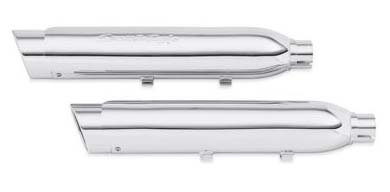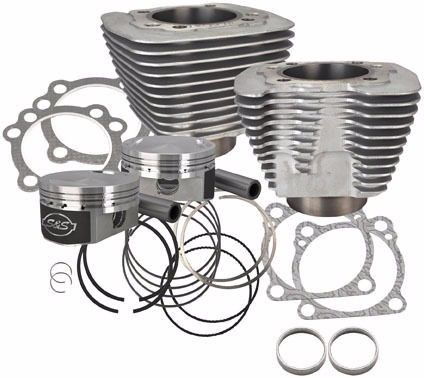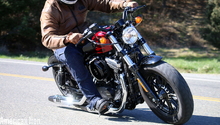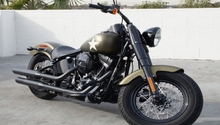Harley Davidson Sportster: Engine Performance Modifications
A cheap wake up call for carburetted Sportsters. Getting a stock EFI Sportster to wake the neighbors and clear the cobwebs, plus extreme measures for extreme horsepower.
This article applies to the Harley Davidson Sportster.
Sportsters are small and perfectly formed, but as stock they are not slow (they are a quad-cam engine). The XL series was Harley Davidson's first Superbike, the V-Rod of its day, but you might want to get more out of it and here are some pointers as to what you can get and what to expect.
Three Stages for Three Budgets

Waking up a Sportster is easy initially, as you just have to overcome the neutered state the EPA requires them to leave the factory in. So pipes and an air cleaner will give you an effective boost. Once that thrill wears off, you can change the camshafts but after that it gets expensive as major engine modifications (often irreversible) will need to be done and reliability may suffer; although, it is your bike and your money, so read on and see where your budget and skill level can take you.
Read the forum links for more information on upgrading a Sportster and interact with the forum before ordering any parts or commissioning any work. The forum can teach you a lot and save you a heap of money.
Stage 1 – Undoing the EPA Impositions

DIY Cost – $220-$1,750 (carburetor); $550-$2,500+ (EFI)
Professional Cost – $350-$2,500
Skill Level – Easy; only basic spanner skills are necessary, but you still need to take your time and know when to ask for help.
The main things that hold back the performance on a Sportster are the air cleaner and the exhausts. EPA are obsessed with noise and emissions, so restrict air cleaner designs, muffled exhausts and very lean fuel settings that are in the way of unleashing the beast.
Changing the air cleaner, adding loud exhausts and adjusting the fuel mix is very easy on both carburetted and EFI (fuel injected) bikes, but different processes are used to change the fuel settings.
Choosing which parts to fit can be a daunting task and the price range of available parts even more of a challenge. To make sure you have parts that will fit and work those with less knowledge might want to stick to the Harley Davidson - produced "Screamin' Eagle" (SE) range; it fits, it works, as simple as that.
Air Cleaner
Fitting a SE or K&N replacement air cleaner filter is as simple as unbolting the air cleaner cover, removing the screws that retain the air filter element and putting it all back together with the upgraded filter in place. These filters will allow the bike to ingest more air and it is the amount of air that gets burnt during the combustion stage of the running cycle that determines how much power the engine will produce.
Exhaust
If you have limited mechanical skills, then stick to slip-on muffler, so you will not run the risk of snapping one of the exhaust studs that mount the actual pipes into the cylinder head. A 2-1 system or a set of aftermarket 2-2 exhausts will likely give more power, but you need to have experience of removing exhaust flange studs successfully.
Fuel Adjustments - Carburetor
If your Sportster has a carburetor, you will need to change the jets and the needle position. This is a bit of a science, but the basic rule for the setup described above is to add 15% to the main jet figure (eg 170 main jet + 15% = 195), which even if it isn't spot-on, it will stop the bike from melting pistons while you adjust the settings. The best guide to determining whether the settings are correct can be found in the Mikuni HSR42 installation and tuning guide, they make it really easy to understand and the guide is downloadable from their website.
The needle in the slide will require a 2mm shim fitted where the needle sits in the slide and the idle jet should be changed for a #45 or #48.
If you have an extra $450 or so in your budget, you could opt for a larger carburetor such as a 42mm Mikuni or an S&S Super E; both give noticeable gains in power.
Fuel Adjustments EFI
To adjust the fuel setting on the EFI bikes, you will need a "Tuner." This is a small computer that interferes with the signals coming from the ECU module to allow more fuel to flow into the engine at any given rev or load range. They come in various types and prices and either have downloadable maps or manually adjustable settings. Some are "self-tuning" in as much as you just fit them and they work out what the bike needs with no input from you or your laptop. Look for Rev Tech, Ultima, Cobra, Vance and Hines Fuel Pak and Power Commander.
883 - 1200
If your Sportster is an 883 and built before 2008, it can be bored out to 1200 using the existing cylinders and a set of 1200 conversion pistons. This will give you a 40% increase in power and cost around $450 DIY on top of the budget given above or $1,000 fitted. For EFI bikes, you will need to add a tuner and have the ECU "Flashed" at a dealership (they need the whole bike for this) before fitting the tuner, this will add $650 to $1,000 to your budget.
For both types of bikes, a dyno setup will be the most accurate way of maximizing the gains to be had from the upgrade, but it could add up to $400 to the budget.
Post 2008 models will require cylinders and pistons, as they cannot be bored out using the stock cylinders. The conversion kit is $1,050 including gaskets and fitting around $500; you will also need the tuner and possibly the ECU flash.
Your Sportster will now be faster and louder! There is no downside to this level of upgrade, as it lets the bike do what Harley Davidson designed it to do way back in the day when exhausts were louder and life was less regulated.
Stage 2 – Camshafts and Simple Head Work

DIY Cost – $600-$2,500
Professional Cost – $1,200-$3,200
Skill Level – Moderate; you will need the manual and possibly some specialized tools, or the ability to make them.
Camshafts
Simply put, camshafts change how deeply the engine breathes. Big breaths mean more air is burnt and that gives you more power; they also change when the bike breathes. For this level of upgrade, you should stick to a "bolt-in" camshaft; that means it can be fitted with no other mechanical modifications to the engine internals, but will still give you a radical increase in power.
Fitting camshafts in a Sportster requires the cylinder heads to be removed in order to take the spring pressure that the valve gear exerts on the camshafts off the camshafts, so you can remove the stock ones and refit the new ones.
Paying attention to the timing marks and cylinder head torque procedures is vital here. If you don't know what that means, then don't attempt the job yourself or buy the manual and read it thoroughly before deciding to attempt the job.
Cylinder Heads
While the heads are off during this upgrade, you can send them off to have them modified to increase gas flow through the inlet and exhaust ports, or to have them skimmed to increase compression and "squish" (how hard the gasses are compressed prior to ignition). These sort of modifications will increase the gains that the camshafts will give you.
Clutch
At this stage in the proceedings the clutch (especially true of EFI models) will need a heavy duty spring added. These can be obtained from Barnett or Screamin' Eagle ($28 DIY or $150 fitted) and will need a special tool made, bought or borrowed to do the job.
This level of upgrade may move the power band up the rev range, but you will still have more grunt in the low to mid-range and this is a general characteristic of bolt-in camshafts. They give a reasonably even spread of power and more of everything, mostly right where you want it.
Ignition Module
You can add an aftermarket module or aftermarket ignition system to give it a higher rev limit (not recommended), or a different ignition advance curve to keep the engine from pinging or running hot ($225 DIY or $400 fitted).
You will now be very happy with your Sportster's performance but a bit lighter in the wallet. what comes next is seriously expensive, so maybe leave this article now.
Stage 3 – More of Everything!

DIY Cost – $1000+
Professional Cost – $2,000 (Leave them your credit card details and shut your eyes)
Skill Level – Difficult; you will need a high level of engineering skills.
OK, so you're still here? This means you are committed to getting every last horsepower out of your Sportster. It isn't easy and it isn't cheap!
What we are looking at here is extreme everything. I'm talking about some seriously hot camshafts that are designed to give huge amounts of power and this means that your valve gear will have to be extensively modified, so that the valves stay out of the way of the pistons when the engine is running.
It means that the compression ratio will be raised by altering the cylinder head. The inlet and exhaust ports will need modification and possibly even larger valves.
The pushrods will need to be changed and you might even go to a 1250cc big bore kit and an upgraded crankshaft. The sky (or rather your budget) really is the limit!
You can add a larger carburetor or if it's an EFI model, a bigger throttle body, Nitrous Injection for short bursts of extreme boost and some altered gear ratios to keep the revs lower. You can radically alter the ignition maps and let it rev to 8,000rpm (stock is 6,200rpm).
These mods will give you up to 100 horsepower and leave you dollar poor, but rich in adrenaline and bragging rights.
Understand your riding style and think about why you ride a Sportster. Don't just go for big numbers because while a 70 horsepower bike has usable power in the low to mid-range, a 100 horsepower bike will be quite challenging to ride in town or on anything other than dead straight and well-surfaced roads.
Lots of people make the mistake of "going for the big numbers" and then find the bike isn't fun to ride anymore. Start with Stage 1 and be honest with yourself about whether it does what you want it to do and suits your needs.
Related Discussions
- What Did You Do to Your Sportster Today? - HDForums.com
- How to Make My Iron 883 Faster- HDForums.com
- Engine Upgrades for the 1200 - HDForums.com







